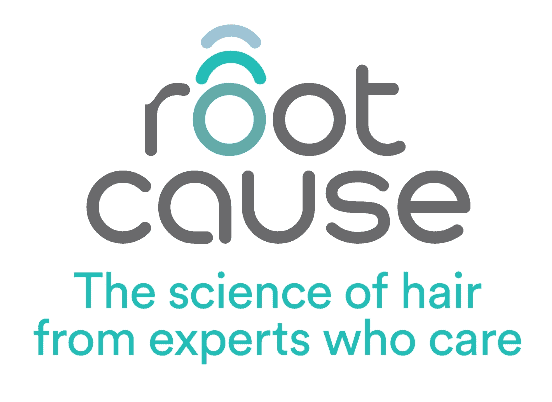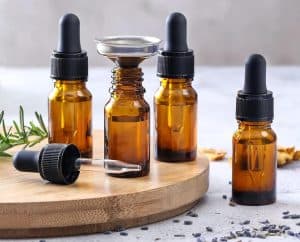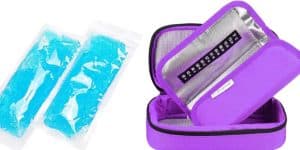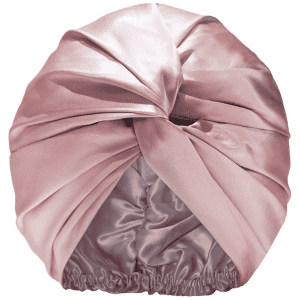USING TOPICAL SCALP LOTIONS
SOME HELPFUL HINTS AND INSTRUCTIONS
Q: Should the lotion be across the whole scalp or mainly the areas that show recession?
A: For lotions such as minoxidil, focus your application on the sites of concern, however, this does depend on the diagnosis as some conditions tend to develop over time, so your trichologist may direct you to cover the areas that the hair loss normally progresses next.
For example, for androgenetic alopecia in men, there is typically recession at the temples but may not yet be on the vertex, however, some application on the latter even can be helpful when developing a clients long-term treatment pathway.
The key here is to discuss with your trichologist, they are there to support your health journey and provide regular and up-to-date expert advice.
Remember to follow the amount you need to apply (and ensure you are measuring correctly each time, do not rely on an estimate) as this ensures you do not apply too little or too much. Absorption into the body may affect the heart and blood vessels and cause unwanted effects.
Q: Should I massage the lotion into the scalp or just apply and leave it?
A: Ideally, gently massage into the scalp, and thoroughly wash hands with soap afterwards. Ensure your scalp is completely dry before application. Do not dry your scalp with a hairdryer as this can make the treatment less effective.
You can use a cotton bud to apply to your scalp if you wish.
For any prescription/ topical scalp lotion, please be aware of the dangers of the lotion getting near the eyes or open wounds. Take care to apply, and watch carefully for any habits such as itching, picking or rubbing the hair/ scalp area afterwards and then accidentally transfer to the body/ eyes, or externally to someone else/ food items etc. Eye infections can occur for instance when rubbing your eyes after touching the scalp.
Q: I have long hair, does the lotion damage the hair shaft? What should I do?
A: The lotion shouldn’t run onto the whole length of the hair but should clearly touch the roots but shouldn’t damage them.
Use your regular moisturising/ conditioning hair care products and everything should be fine.
Q: What is Trichosol, the solution my medication is compounded with?
A: Trichosol is a water-based solution which has natural minerals from plants. It does NOT contain alcohol or propylene glycol. To learn more about the clinical studies of Trichosol CLICK HERE.
Alcohol and propylene can be sensitive to scalps, and can lead to dryness and irritation. It can also leave hair dull.
The Benefits of TrichoSol™
- It is a soft formula that does not use any gases
- It can mix well with water-soluble and fat-soluble ingredients, such as minoxidil, that help your hair
- It does not irritate your skin
- It does not make your hair dry
- Water: The main component of TrichoSol, which makes it a hydrophilic (water-loving) solution.
- Glycerin: A moisturising agent that helps keep the skin and hair hydrated and soft.
- Sodium chloride: A salt that helps balance the pH and osmolarity of the solution.
- Potassium chloride: Another salt that helps balance the pH and osmolarity of the solution.
- Magnesium chloride: A mineral that helps improve the cellular environment of the hair follicles and stimulate hair growth.
- Calcium chloride: Another mineral that helps improve the cellular environment of the hair follicles and stimulate hair growth.
- Sodium lactate: A natural preservative that helps prevent the growth of bacteria and fungi in the solution.
- Lactic acid: A natural acid that helps adjust the pH of the solution and enhance the penetration of the active ingredients into the skin and hair.
Q: Will I see hair growth immediately?
A: Medication generally needs time to see results. Some hair and scalp conditions can be unpredictable so careful monitoring is essential. Your trichologist will advise the expected response from applying your scalp lotion as this will vary depending on your condition, the prognosis, the medication strength and other factors including your general health, diet, lifestyle and environment. It is important not to be unnecessarily anxious as that can also impact on your hair growth! Most treatment pathways are three, six or twelve months and your initial medication is a first protocol treatment and will be reviewed, and it is not unusual to revise using different strengths or alternative medications.
Q: What is 'dread shed'?
A: Initial shedding of the hair on commencement of taking medications such as minoxidil is a common side effect. This is usually temporary and occurs in the first few weeks of treatment while the medication stimulates hair growth.
For example, a 2024 study suggests 5.2% of patients applying minoxidil experienced initial shedding. Again, your trichologist will discuss this with you, and any unusual changes should be reported immediately to ensure adequate monitoring and a personalised approach to your needs.
Q: Where should I store the bottles/ containers of scalp lotion?
A: Store your lotion at room temperature, in the original closed container, or if you have transferred to a different container, keep that tightly sealed. Most containers won’t have child-locks so please store away from children and pets. Keep lotions away from moisture (e.g. showers) and direct light and heat.
Remember to shake the bottle well before use, and keep bottles tightly shut between applications. Keep the bottles clean and free from drippage.
Your lotion will likely have a use by date – do remember to follow this.
Q: Is it ok to use a topical solution when I have pets?
A: As mentioned, it is essential to ensure you do not transfer any solution to your clothing, other parts of the body/ skin or to other people and pets.
While solutions such as Minoxidil is safe and effective for humans to use (following instructions carefully) it can be harmful for pets such as cats and dogs.
Even small amounts of solution exposed to pets can be harmful. There have been several studies undertaken, demonstrating major illness or morbidity when exposed.
Pets are affectionate and will rub against you, and want to lick your hands and face, therefore, can be at risk at exposure.
As detailed previously, once you apply your solution, ensure your hands are thoroughly washed (and you can use cotton buds), and using a silk turban would be recommended to ensure your pets keep completely away from any potential transference. Store your medication and turban away from your pets. Remember if any transference occurs to your bedding or sofa, your pets may be invertedly affected.
If you are still concerned, you can consider oral medication as an alternative.
Q: I am going on holiday; can I leave the lotion at home for a week and begin using it again when I return?
A: It is fine to skip a day across a month, but not for a whole week as the treatment loses its efficacy. The hair follicles need constant stimulation from the lotion ingredients, otherwise hair growth gained can be lost.
Q: Can I take the lotion on holiday?
A: The bottles come in 60ml or 100ml sizes, however, if you wish to take a smaller bottle, please purchase a tinted (amber/ red) plastic or glass bottle, as it provides better protection due to being impervious to air and moisture, and protects the contents from UV light and certain wavelengths. Ensure it is securely packed in a closed bag (be aware that pressure during flights can burst containers). Where possible ensure it is stored where it is not too cold or too warm. One option is to purchase a travel insulin cooler bag.
Q: When should I apply the lotion?
A: There are different school of thoughts for application timing. Pharmacists often suggest applying at night, while many trichologists, dermatologists and doctors see good results by applying in the morning
Either way, there are some guidelines that can be followed. The aim is to have the application on the scalp ideally for 12 hours, but at least 4 hours.
Ensure the scalp is completely dry after application before going to bed or doing exercise/ styling hair.
If applied in the morning, there is no need to re-apply in the evening unless the hair is washed.
Try to keep to a habit – either mornings or evenings rather than regularly switching.
Q: Do I need to wash my hair daily?
A: There is no need to wash hair daily, although some people rinse daily as they find it sticky. You can re-apply every day without washing, and it will still penetrate.
Most people wash their hair around twice a week, and sometimes rinse occasionally rather than wash.
Do not shampoo your hair until at least four hairs after application.
Q: Is it ok for my bedding to sleep with the lotion on my scalp?
A: In theory, if the lotion is completely dry before going to bed it should be ok. This is one reason for applying in the morning rather than night. It’s important that we limit the transfer from the scalp to the pillowcase, particularly, as the eyeline area can also touch the pillowcase.
We suggest changing the pillowcase 2-3 times per week and turn the pillowcase over nightly.
Using a satin/ silk turban/ wrap can be helpful, but not for those with fragile hairlines as the friction can damage or break new hair growth. Discuss with your trichologist what option would suit you best.
Remember, lotions can cause staining to your clothing or bedding.
Q: Can I apply the lotion every other day rather than every day?
A: It is important to follow the prescription/ instructions. Of course, if an occasional day is skipped due to circumstances, that is acceptable, but generally it is important to apply daily (or twice-daily) as per instructions. Your trichologist will advise where the lotion should be applied on your scalp. This is one of the advantages of lotion versus tablets - it can be applied locally to specific areas of hair loss.
Q: If I miss a day, should I apply double the dose on the following day?
A: No that isn’t necessary. Simply keep to your regular dose the next day or next application, never double dose.
Q: Do I need to shampoo the lotion off? Or can I just rinse?
A: It is best to shampoo to avoid the lotion ‘running-off’ and spreading to the face. If rinsing, be careful of keeping the hair away from the face etc. However, there is no need to daily shampoo, you can re-apply.
Q: I have just been prescribed antibiotics' while I am using the lotion it that ok?
A: Lotions such as minoxidil should not negatively interact with antibiotics. However, we would recommend you advise your doctor what prescription/ lotion you are using for your hair and scalp before starting your antibiotic course and vice-versa advise your trichologist of the antibiotic prescription to ensure you have been given the most up-to-date advice.
Q: Can I be exposed to the sun after applying the lotion?
A: Yes, but we would always recommend taking appropriate sun protection actions. For example, a straw hat (protective but still breathable) can be helpful but remember it may not completely protect you in direct sunlight. Some additional advice can be found from the Skin Cancer Foundation.
If you have had sun exposure to your scalp or any other irritation, do not apply anything until your scalp has fully recovered.
Q: Is it ok to swim while using the lotion?
A: Ideally, we would suggest you use a swimming cap to ensure the ingredients do not enter the general swimming water, including outdoors. This is more preventative and respectful for other swimmers and water-life.
For example, research shows the negative impact of general sunscreens making their way into marine life, so we know that scalp lotions are unlikely to be environmentally friendly.
It is best not to apply immediately before swimming, or to immediately wash off after swimming to avoid ‘running-off’ onto the face.
Q: Should I continue to apply the lotion after coming up with a rash/ irritation?
A: Seek medical/ trichologist advice immediately if any rash or other side-effect appears on or around the scalp area after commencing application of the lotion. It may not be the lotion, but we always encourage clients to be cautious. You will have been asked for a full medical history beforehand and this includes allergies and intolerances.
Scalp lotions can have some side effects, mainly rare instances, but do read the instructions carefully. For example, effects such as itching, or inflammation might occur.
Carefully examine your scalp on application – we recommend taking photographs before you begin, and regularly throughout your treatment. This not only provides evidence of hair growth, but any side-effects that may emerge.
This is a general information sheet to support your treatment pathway but does not replace personalised medical guidance – we would always encourage you to discuss any concern with your trichologist and/ or doctor. No question is daft – our trichologists would be delighted to hear from you!
APRIL 2025



